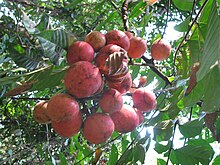
Antidesma is a genus of tropical plant in the family Phyllanthaceae formally described by Linnaeus in 1753. It is native to tropical Africa, S + E + SE Asia, Australia, and various oceanic islands. The greatest diversity occurs in Southeast Asia.

Canarium is a genus of about 120 species of tropical and subtropical trees, in the family Burseraceae. They grow naturally across tropical Africa, south and southeast Asia, Indochina, Malesia, Australia and western Pacific Islands; including from southern Nigeria east to Madagascar, Mauritius, Sri Lanka and India; from Burma, Malaysia and Thailand through the Malay Peninsula and Vietnam to south China, Taiwan and the Philippines; through Borneo, Indonesia, Timor and New Guinea, through to the Solomon Islands, Vanuatu, New Caledonia, Fiji, Samoa, Tonga and Palau.
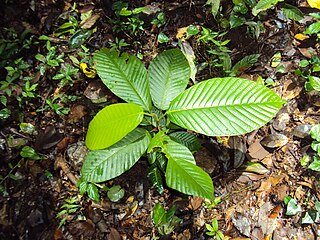
Dipterocarpus is a genus of flowering plants and the type genus of family Dipterocarpaceae.

Daemonorops was a genus of rattan palms in the family Arecaceae. Its species are now included within the genus Calamus.
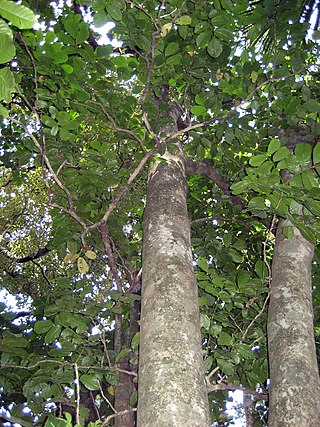
Dysoxylum is a flowering plant genus of trees and shrubs from the mahogany family, Meliaceae.

Phoebe is a genus of evergreen trees and shrubs belonging to the Laurel family, Lauraceae. There are 75 accepted species in the genus, distributed in tropical and subtropical Asia and New Guinea. 35 species occur in China, of which 27 are endemic. The first description of the genus was of the type species P. lanceolata made in 1836 by Christian Gottfried Daniel Nees von Esenbeck in Systema Laurinarum, p. 98.

Chionanthus, common name: fringetrees, is a genus of about 140 species of flowering plants in the family Oleaceae.

Actinodaphne is an Asian genus of flowering plants in the laurel family (Lauraceae). It contains approximately 125 species of dioecious evergreen trees and shrubs.
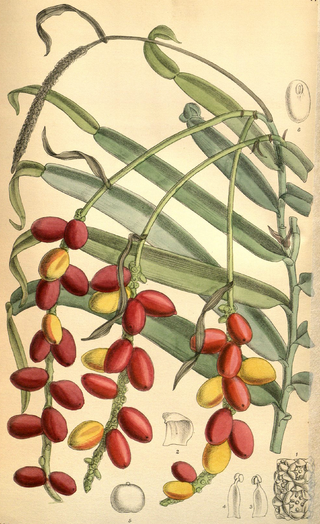
Pothos is a genus of flowering plants in the family Araceae. It is native to China, the Indian Subcontinent, Australia, New Guinea, Southeast Asia, and various islands of the Pacific and Indian Oceans.

Barringtonia is a genus of flowering plants in the family Lecythidaceae first described as a genus with this name in 1775. It is native to Africa, southern Asia, Australia, and various islands of the Pacific and Indian Oceans. The genus name commemorates Daines Barrington.
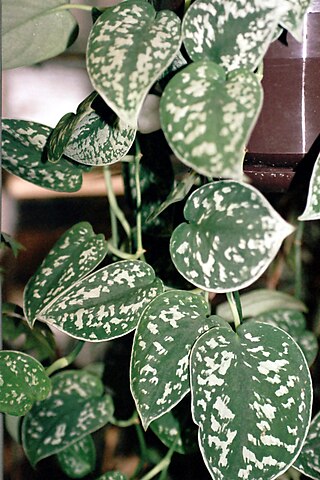
Scindapsus is a genus of flowering plants in the family Araceae. It is native to Southeast Asia, New Guinea, Queensland, and a few western Pacific islands. The species Scindapsus pictus is common in cultivation.

Didymocheton is a genus of flowering plants in the family Meliaceae. It includes 41 species which range from eastern India through Indochina and southern China to Malesia, Papuasia, eastern Australia, New Zealand, and the South Pacific.
Prasoxylon is a genus of flowering plants in the family Meliaceae. It includes seven species which range from Nepal and eastern India through Indochina to southern China, Taiwan, Malesia, Sri Lanka, Papuasia, and Queensland.

Urceola is a plant genus in the family Apocynaceae, first described as a genus in 1798. It is native to China, the Himalayas, Southeast Asia, and New Guinea.

Phrynium is a genus of flowering plants native to China, India, Southeast Asia, New Guinea and Melanesia. It was described as a genus in 1797.
Teijsmanniodendron is a genus of flowering plants in the mint family, Lamiaceae, first described in 1904. It is native to Southeast Asia and Papuasia.
Micrechites is a genus of flowering plants in the family Apocynaceae, first described as a genus in 1857. It is native to China, the eastern Himalayas, Southeast Asia, Papuasia, and Queensland.
Epicharis is a genus of flowering plants in the family Meliaceae. It includes seven species which range from Indochina to south-central China, Taiwan, Malesia, Papuasia, Queensland, and Fiji.
